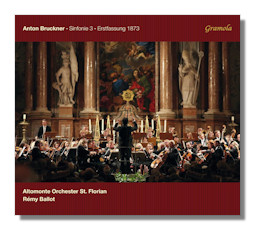
The Internet's Premier Classical Music Source
Related Links
- Bruckner Reviews
- Latest Reviews
- More Reviews
-
By Composer
-
Collections
DVD & Blu-ray
Books
Concert Reviews
Articles/Interviews
Software
Audio
Search Amazon
Recommended Links
Site News
 CD Review
CD Review
Anton Bruckner

Symphony #3 (original 1873 version)
Altomonte Orchestra, St. Florian/Rémy Ballot
Gramola 99044
Even by the standards of Bruckner's symphonies the Third had a sad and complex history. The original 1873 version of Bruckner's Third Symphony was dedicated to Richard Wagner, the composer's hero – an appropriate dedicatee for a monumental work 2,056 bars long and containing a number of quotations from Tristan and the Ring. The 1873 version was not performed during Bruckner's lifetime – in fact, the first performance did not take place until 1946 (under the direction of Joseph Keilberth). In 1877 Bruckner himself conducted a disastrous premiere of a revised version with the Wagner references deleted. The audience and most of the orchestra left before the end. More cuts and rewriting followed over the next decade or so, culminating in the 1889 version, which was included in Bruckner's official edition and until recently the only version played regularly. The finale of the 1889 version bears the strong imprint of Joseph Schalk, who bears much responsibility for a finale cut by 40%. The 1889 version ended up with 1,644 bars in total.
What is distinctive about this performance from Rémy Ballot and the Altomonte Orchester is not so much that they play the original 1873 version of the Third Symphony. The original version has been played increasingly frequently in recent years, starting with Inbal's pioneering recording with the Frankfurt Radio Symphony (Apex CD 2564-60005-2). The unique feature of this performance is that it was recorded live in the Priory of St. Florian, Bruckner's spiritual home and where he is buried. The Altomonte Orchester is the festival orchestra of the International Bruckner Festival, housed at St. Florian and named after the brothers who painted the frescoes in the Priory.
The acoustics at St. Florian are famous for their echo, which lasts up to 10 seconds. This obviously poses a challenge to orchestra and conductor. Ballot and the Altomonte rise to the challenge with by far the slowest recording ever made of the Third. The performance lasts a full 90 minutes – in comparison, for example, to Roger Norrington's brisk 57 minutes (Hänssler 93.217). The longest recording that I can find is by Georg Tintner, coming in at 77 minutes. To get a sense of the differences in scale, Ballot's opening movement lasts for an imposing 32'35", while Norrington's is only 19'57".
When playing Bruckner so slowly the trade-off is between momentum and majesty. The surroundings of St. Florian must have added significantly to the majestic end of the scale, but of course none of that comes across in the recording. To my ear the jury is still out on the first movement. There are powerful moments, but too often the musical line appears to be moving in slow motion and almost grinding to a halt. The second movement is a different story. In this performance it comes across very clearly as the first of Bruckner's truly great slow movements, revealing unexpected depths and grandeur, particularly in the closing minutes. The last two movements are mixed. When set up by the Adagio the tempo of the Scherzo seems right, although if played on its own it would most likely seem woefully slow. The Trio, though, seems very lethargic. In neither case do we have much of a dance. This is particularly problematic in the Finale. As Norrington persuasively illustrates in his performance of the 1873 version, the last movement is built around the juxtaposition of polka and funeral march. The score contains energy, tragedy, and humor, but the first and third are very much in the background in Ballot's performance.
Even with these reservations this disc is definitely worth listening to. The slow movement is sublime and it is refreshing to listen to a conductor who turns his back so emphatically on the current vogue for Bruckner-lite. I wish I'd been there at the performance. It must have been a monumental occasion.
Copyright © 2014, José Luis Bermúdez




















